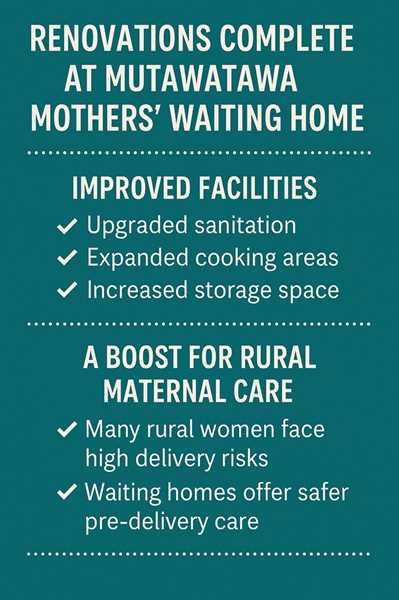
ZimNow Reporter
The recently completed renovations of the Mothers’ Waiting Home at Mutawatawa District Hospital in Mashonaland East are a crucial step toward reducing maternal and neonatal mortality in rural Zimbabwe.
The upgraded facility now boasts improved sanitation, expanded cooking spaces, and increased food and essential supply storage, creating a safer, more dignified environment for expecting mothers during their final weeks of pregnancy.
According to the Ministry of Health and Child Care (@MoHCCZim), the enhancements aim to encourage more rural women to make use of institutional maternal care rather than attempting risky home births far from medical help.
Mothers’ waiting homes are residential facilities located near hospitals or clinics, where pregnant women—particularly from remote areas—can stay as they await labor. The World Health Organization recommends this model as a key intervention in improving maternal and neonatal outcomes in low-resource settings.
Related Stories

Zimbabwe continues to face high maternal mortality rates, particularly in rural districts. According to UNICEF and the Zimbabwe Demographic and Health Survey (ZDHS):
- The maternal mortality ratio in Zimbabwe was 462 deaths per 100,000 live births (2019).
- Many of these deaths occur during labor, delivery, or within 48 hours postpartum.
- Rural women are twice as likely to give birth at home compared to their urban counterparts.
Distance from health facilities, lack of transport, poor road infrastructure, and cultural or economic barriers all contribute to delayed care and life-threatening complications.
Various voices are on record saying that scaling such efforts across all provinces—while addressing underlying issues like staffing, transport, and emergency care—will be key to achieving the Sustainable Development Goal of reducing maternal mortality to fewer than 70 per 100,000 live births by 2030.
For now, the upgrades at Mutawatawa offer a promising reminder that small, practical improvements in infrastructure can yield transformative outcomes for Zimbabwe’s health delivery system.



















Leave Comments